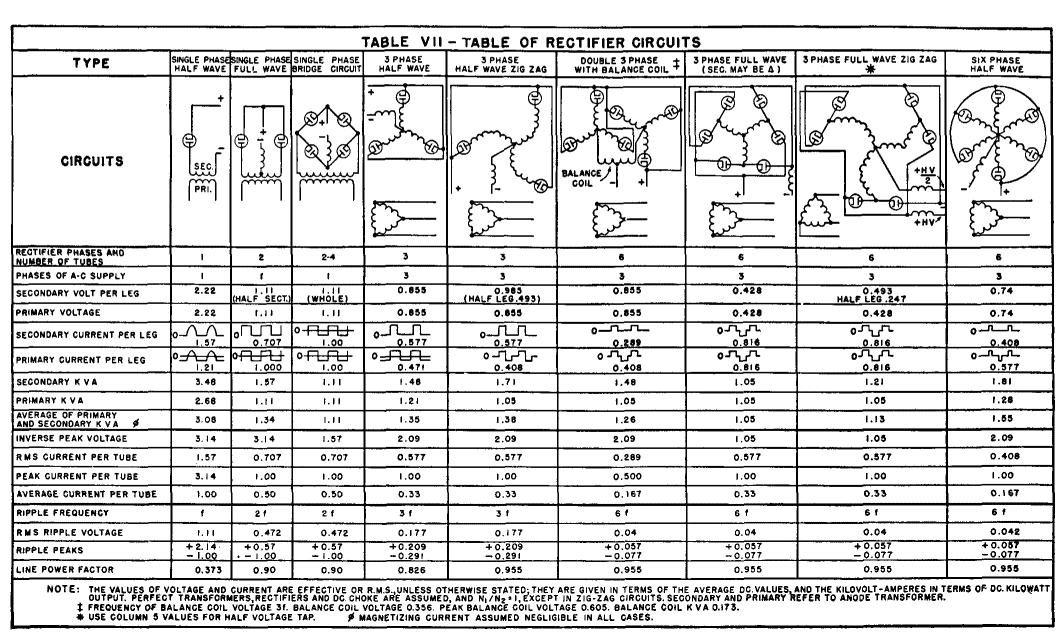basic 3-phase xfmr power supply questions. re:7i29
- jCandlish
-
 Topic Author
Topic Author
- Offline
- Premium Member
-

- Posts: 151
- Thank you received: 4
I have a 380v 3-phase transformer with a Delta connected primary and 6x100v (3x200v centertapped) secondaries.
My goal is a power supply sufficient for (2* 4.3Nm + 1* 6.4Nm) DC-Servomotors. I envision using 2* 7i29 motion control boards in this application. The 4.3Nm servos develop 36Nm peak.
Each core section of my transformer has the following windings:
Making the complete diagram appear so:
The center-taps suggests that the original application was a six-phase star:
However, unless I am mistaken, paired bridges would be a better circuit for this application, with each bridge supplying a separate 7i29:
I do not understand the derivation of the 2500VA rating on this transformer. The dataplate is in the 2nd photo.
Is it correct that the primary is 3 * 380V * 3.8A == 4332VA ???
Is it correct that the secondary is 6 * 100V * 6.2A == 3620VA ???
I guess the rating is for six-phase star wireing, which for a utilization factor of ~ 1.8 would give a capacity of approx. 2.4KVA.
Which brings me to my question about the current rating for the secondary windings. Is this rating the average current? 'Cause in the six-phase star wireing, each diode is conducting only 1/6 of the time, so for 2500VA then 25A peak current (or somewhat less nominal RMS) would be required.
So in the case of wiring the transformer as two 100v bridges, for a utilization factor of 1.05 wouldn't the capacity of each bridge be aprox. 3620VA / ( 2 * 1.05 ) ~= 1725VA ???
Except that the dual bridge wiring mandates two separate reverse EMF filters, wouldn't that be the best scheme for supplying two 7i29 boards???
Is there something I've missed??? What have I got wrong???
Thanks for crosschecking my homework.
_jC
.
Please Log in or Create an account to join the conversation.
- andypugh
-

- Offline
- Moderator
-

- Posts: 23461
- Thank you received: 4992
However, unless I am mistaken, paired bridges would be a better circuit for this application, with each bridge supplying a separate 7i29:
I think it would be better to have the 7i29s all share one DC bus. That way each transformer winding has an equal current, rather than one running one motor, and the other running two. You can also then have one large smoothing cap set, rather than having to have two.
Please Log in or Create an account to join the conversation.
- jCandlish
-
 Topic Author
Topic Author
- Offline
- Premium Member
-

- Posts: 151
- Thank you received: 4
_jC wrote:
However, unless I am mistaken, paired bridges would be a better circuit for this application, with each bridge supplying a separate 7i29:
I think it would be better to have the 7i29s all share one DC bus.....
Yes, but in this case the utilization factor of the transformer is quite poor. 1.81 vs 1.05.
And it is not clear if the secondary windings can supply the required peak current for the 6-phase-star circuit.
Thanks again
_jC
.
Please Log in or Create an account to join the conversation.
- PCW
-

- Away
- Moderator
-

- Posts: 19072
- Thank you received: 5262
Please Log in or Create an account to join the conversation.
- jCandlish
-
 Topic Author
Topic Author
- Offline
- Premium Member
-

- Posts: 151
- Thank you received: 4
I'm with Andy , the first circuit (3 paralleled full wave center tap rectifiers) is best, not only that, the second circuit will explode (its has diodes across transformer legs)
I'm not following you. When you say 'diodes across xfmr legs' do you mean the null reference to the center taps?
How about this then? This is the same circuit without the null reference:
Also, what about the current in the 6-phase-star? My transformer is rated at 6.2A per secondary winding, and in the 6-phase-star only one diode is conducting at a time.
Wouldn't that limit my transformer to 620VA?
Isn't the 6 diode circuit, by only drawing current from one winding at a time, underutilizing the transformer?
Thanks again
_jC
.
Please Log in or Create an account to join the conversation.
- andypugh
-

- Offline
- Moderator
-

- Posts: 23461
- Thank you received: 4992
I'm not following you. When you say 'diodes across xfmr legs' do you mean the null reference to the center taps?
Yes, if you shuffle things around you can see there is a diode from each centre tap to each output leg.
The duty-cycle of each diode/winding will rather depend on how far below bus voltage the capacitor has drooped since the previous voltage peak, so I don't think that it is as simple as considering utilisation ratios.
Incidendtally, eBay can be a good source of big smoothing caps, for example:
200732340370
110868659041
Please Log in or Create an account to join the conversation.
- jCandlish
-
 Topic Author
Topic Author
- Offline
- Premium Member
-

- Posts: 151
- Thank you received: 4
The duty-cycle of each diode/winding will rather depend on how far below bus voltage the capacitor has drooped since the previous voltage peak, so I don't think that it is as simple as considering utilisation ratios.
Still, the best case for the 6-phase-star is a duty cycle of 1/6, while for each full bridge the duty cycle is 1/3 and two diodes thus two windings are conducting simultainiously.
In this curcuit, when loaded, 4 diodes and windings would be loaded.
It seems to me that the double bridge circuit delivers almost twice the power from the same transformer as the 6-phase-star. If you can use it that way.
If the primary of my transformer is ~ 4300VA (3*380V * 3.8A) why should the transformer be rated as 2500VA?
How much power could I expect to be able to draw?
You would have to agree that there is quite some difference in 4300VA, 2500VA, and if the secondaries are peak rated 630VA.
If the secondaries are average current rated, then wouldn't 6*100V * 6.3A imply a 3620VA capacity? I don't see where the 2500VA number is comming from, and so don't know how to achive it.
Why would the primary be rated so much higher than the total capacity?
Incidendtally, eBay can be a good source of big smoothing caps, for example:
I have a boatload of big caps from my valve amp projects.
thx
_jC
.
Please Log in or Create an account to join the conversation.
- andypugh
-

- Offline
- Moderator
-

- Posts: 23461
- Thank you received: 4992
[
It seems to me that the double bridge circuit delivers almost twice the power from the same transformer as the 6-phase-star. If you can use it that way.
Do you need to tie the star-points together? I think you can let them float (as they will float to the same level). But I am absolutely no expert, in fact I have never looked at a 3-phase transformer diagram before.
If the primary of my transformer is ~ 4300VA (3*380V * 3.8A) why should the transformer be rated as 2500VA?
It might be as simple as the difference between coil rating and overall transformer rating, which all basically comes down to heat dissipation.
Just check that they are low ESR, but then they probably are.I have a boatload of big caps from my valve amp projects.
Please Log in or Create an account to join the conversation.
- PCW
-

- Away
- Moderator
-

- Posts: 19072
- Thank you received: 5262
Please Log in or Create an account to join the conversation.
- jCandlish
-
 Topic Author
Topic Author
- Offline
- Premium Member
-

- Posts: 151
- Thank you received: 4
Do you need to tie the star-points together? I think you can let them float (as they will float to the same level). But I am absolutely no expert, in fact I have never looked at a 3-phase transformer diagram before.
No, but the center-taps were tied together when I received the transformer, futhermore it is the only way to use the transformer with all the windings and have a 100V secondary. You could wire a 100V Delta secondary, but only with half the windings.
The first circuit is the only workable one if you want to run 7I29s, otherwise your output voltage will be doubled (so ~280V instead of ~140V)
Ok, I get it. For the 3-phase bridge, the recification ratio Vin(RMS)/Vout(DC) = 0.481 giving aprox. 208V, but for the star its 0.741 ~= 135V.
Bummer.
So at the per secondary winding rated (average) current of 6.2A I would need 40A diodes (37.2),
Or at the rated 2500VA (continuous duty I guess) I would need 25A diodes.
Actually my textbook says the peak current thru the diodes is 6.3 times average current?
And the diodes should be rated for a peak inverse voltage 2* peak forward V or ~400V?
So it looks like my recifier needs 40A400V diodes. Like the Vishay VS-40HF40. Those are kinda 'spensive. Nuts.
Would someone care to recommend a discrete diode with a case that can be heatsinked to ground potential?
Thanks again
_jC
.
Please Log in or Create an account to join the conversation.









